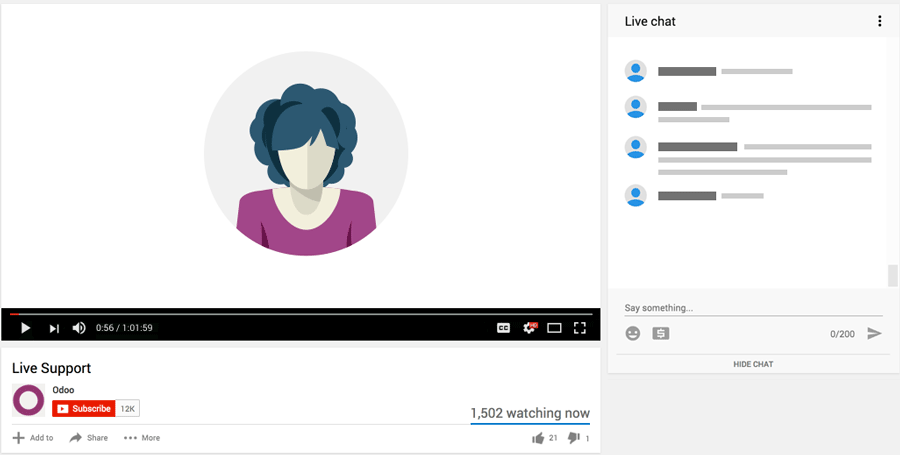I use one of the predefined Charts of Accounts available in Odoo. How can I add a new Account to that chart?
Odoo is the world's easiest all-in-one management software.
It includes hundreds of business apps:
- CRM
- e-Commerce
- Accounting
- Inventory
- PoS
- Project
- MRP
This question has been flagged
You can easily create new accounts or change existing accounts in Odoo, whether you work with a predefined chart or with a chart you created yourself.
To add or modify existing accounts, use the menu Accounting > Configuration > Accounts > Accounts. Click the Create button for a new account, or open the account you want to change.
Instead of creating an account from scratch, you can also duplicate an existing account in case of a predefined chart of accounts. If you duplicate an account like the one you need to create, you don't have to worry about parent account and account type.
The main account fields are:
Account Code and Name
the first field contains the account number: the code length is not limited to a specific number of digits. Use code 0 to indicate the root account. Enter the account name in the second field.
Parent
determines which account is the parent of this one, to create the tree structure of the chart of accounts.
Internal Type
internal types have special effects in Odoo, meaning that some internal types can only be used in certain conditions. By default, the following types are available:
- View can be used to create a hierarchical structure for your accounts (grouping),
- Regular any account that does not fit into one of the other types; most of the accounts will have this type,
- Receivable - Payable: these types are used to indicate the centralisation accounts (for customers and suppliers) that will be set for each partner,
- Liquidity used to indicate financial accounts (bank and cash accounts),
- Consolidation to create a virtual (or consolidation) chart of accounts,
- Closed to indicate accounts that are no longer used.
Account Type
it is important to select the corresponding account type, as explained in the topic about Account types. This will have an impact at year closing and also when printing reports. Use the View type for accounts that make up the structure of the charts and have no account data inputs of their own.
Active
indicates whether an account is still being used.
Default Taxes
this is the default tax applied to purchases or sales using this account. It enables the system to propose tax entries automatically when entering data in a journal manually.
Allow Reconciliation
determines if you can reconcile the entries in this account. Activate this field for receivable and payable accounts and any other account that need to be reconciled other than by bank statements.
When you have installed Multicurrency in Odoo, each account will have two extra fields.
Secondary Currency
forces all the moves for this account to have this secondary currency. Note that you can define exchange rates from the menu Accounting --> Configuration --> Miscellaneous --> Currencies.
Outgoing Currencies Rate
to be selected only when you add a secondary currency. You have two options for outgoing transactions: At Date or Average Rate. Incoming transactions are always calculated At Date, according to the date of the transaction.
The tree structure of the accounts can be altered as often and as much as you wish without recalculating any of the individual entries. So you can easily restructure your account during the year to reflect the reality of the company better.
You can have a look at active charts of accounts using the menu Accounting --> Charts --> Chart of Accounts, and click Open Charts for the selected year, account moves and periods. Click an account to drill down to its details.
Most accounting software packages represent their charts of accounts in the form of a list. You can do this in Odoo as well if you want to, but its tree view offers several advantages:
- it lets you show in detail only the accounts that interest you,
- it enables you to get a global view of accounts (when you show only summary accounts),
- it is more intuitive, because you can search for accounts on the basis of their classification,
- it is flexible because you can easily restructure them.
The structure of the chart of accounts is hierarchical, with account subtotals calculated from the View accounts. You can develop a set of view accounts to contain only those elements that interest you.
To get the details of the account entries that are important to you, all you need to do is click the account's code or name.
Displaying the chart of accounts can take several seconds, because Odoo calculates the debits, credits and balance for each account in real time.
Enjoying the discussion? Don't just read, join in!
Create an account today to enjoy exclusive features and engage with our awesome community!
Sign up| Related Posts | Replies | Views | Activity | |
|---|---|---|---|---|
|
|
4
Mar 25
|
31019 | ||
|
|
1
Dec 22
|
14595 | ||
|
|
2
Dec 22
|
5949 | ||
|
|
4
Aug 24
|
27149 | ||
|
|
1
Apr 16
|
4610 |

